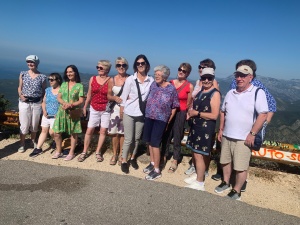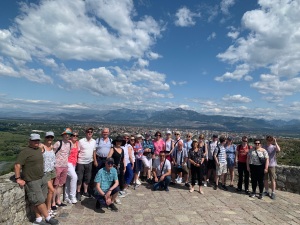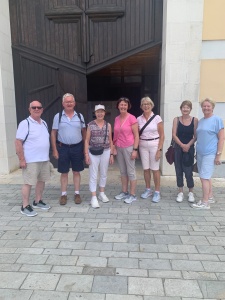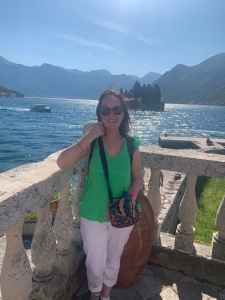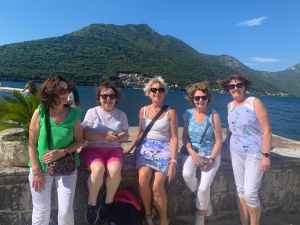It was with great expectation that I embarked on a trip to Montenegro – aptly named Black Mountain – with the RTAI in September. I was not disappointed.
Thursday Day 1: Travel
After a very early start, we arrived in Dubrovnik airport at 12 noon. The weather was overcast, but the temperature has been up at 40° in August and our guide – who met us at Dubrovnik – assured us the weather would pick up, which it did.
There were 14 in the Retired Teachers group, 70 in the bus altogether. At the border between Croatia and Montenegro, we had a long wait for passport scrutiny. Later after about an hour’s drive we got on the ferry to shorten the journey across Boka Bay to our destination, Budva. At around 3.30 we reached our hotel (or hot elle as our guide called it).
Hotel Iberostar is situated about a mile from Budva town in Becici. As we drove towards it, we passed skyscraper after skyscraper of apartment blocks and hotels. Dada, our tour guide, told us that this was all new in the past 20 years. She said that in the year 2000, there were only 11,000 people in Budva. Ten years later they were 18,000. And now with all the influx of refugees, from Ukraine and Russia mainly, there are 45,000. Schools are struggling to keep up.
The rooms were bright, a bit tight for space, but spotlessly clean. Dinner was fantastic, free-flowing wine, all in, and a huge selection of dishes, many prepared on the spot so you could see the making of them there. We were spoilt for choice.
Revived with the excellent cuisine and the wine, and despite tiredness – or maybe because of it – spirits were high at dinner. We heard a story of how one of us women went into our room to discover that there was an adjoining door, a dressing room, no less. She opens the door, only to come face to face with another guest, a male – fortunately not in dishabille. She retreats post haste and only later finds that the man is one of the group and highly amused at the whole affair. A key was promptly produced for the room and so peace and harmony was restored.
Another story was told of a couple who had spent a night in the Maldron hotel in Dublin, to ease the inconvenience of the early start with Aer Lingus. “Did you get value for your money?” a lady from our party enquires of the couple, not for a moment intending a double entendre. The rest of us, in the mood for hilarity, enjoyed the risqué comment all the more. The lady in question, who would never have dreamed of being suggestive, only realised in the retelling what she’d actually said.
Afterwards, we all retired early, happy, exhausted.
Friday day 2: Budva
At 10 o’clock, our guide Dada took us on a bus tour along the coast to Sveti Stefan. This is an island village of 15th century stone built villas overlooking a pink sandy beach and turquoise waters, that once acted as a fortress. It fell into disuse and gradually all the inhabitants left the island. In the 1950’s a wealthy Amam bought the whole shebang and turned it into an exclusive hotel for the rich, leaving the original historic fortress intact. It did indeed look splendid. I must say however, I was pleased to hear that the government is in dispute with the billionaire owners over their claim to exclusive rights to the beach.
After Sveti Stefan, Dada took us to Budva. The main attraction in Budva is the centuries-old walled Old Town. It is a magnificent example of a medieval town. Although it suffered from an earthquake in the 1970’s and was much destroyed, it was painstakingly restored to its former splendour. There are shops and eateries in the old town, but without garish billboards or rails outside their premises to ruin the experience.
Dada left us to our own devices and afterwards, I walked back to the hotel as did many of the others along the beachfront. It was a hot walk. The sun was scorching down. Some who had got back early enough managed to get a lunch in the restaurant and they said it was delicious. Those of us too late for the lunch in the restaurant went to the pizzeria and there found an excellent array of dishes to have out on the terrace.
Saturday day 3: Free day
On Saturday, our free day, a lot of us returned to Budva. Outside of the walled Old Town – or Stari Grad as it is called – there is very little of note. The main attraction is the walled medieval city or Old Town.
With the aim of a walk along the coastline, we made our way down to what turned out to be a shingle beach, full of umbrellas and deckchairs, and holidaymakers. We crossed over to the narrow path, that runs along the cliff edge, until very shortly we came on a statue of a naked ballet dancer, pointing out to sea as she stood on one foot with the other leg stretched behind her and her arm pointing forward. As we approached, a young couple stopped, and the young woman climbed over the fence and across the rocks until she came to the sculpture. Her boyfriend took photographs of her posing beside the sculpture in the same pose, albeit fully clothed.
We continued on along the path and were amazed at the stratification of the limestone cliff to the right that rose up about 30m. It was fenced in by wire, as though there was a danger it might crumble and avalanche at any moment. We continued on until we came to a second beach, much the same as the first, full of umbrellas and tourists lying on sunbeds and swimming and so on. There were eateries around and music blared from a loudspeaker that was somehow attached to the cliff face. On the return journey, we noticed a graffitied sign we hadn’t spotted when we set out: No Entry Due to Danger of Landslide!
Back in the Old Town, we relaxed with a cappuccino in front of the two churches and admired the wonderfully paved square. Afterwards, we went back up to the Citadel and took some more photographs. At the top, we took in the amazing vista and tried to imagine what it would’ve been like years ago when lookouts would have been stationed here all year round on the alert for marauding invaders.
We admired the magnificent mountains, the clear blue sky and sea. But then the high rises…
This part of Montenegro has such a wonderful climate, it’s easy to understand how it has become so commercial. In the Lonely Planet, it is described as the ‘Benidorm of the Balkans’, and that is not far wrong.
Sunday day 4: A drive up the Serpentine and a trip to Cetinje, the old capital
We started out at 8.30, intending to beat the traffic. As our driver took us up the mountains to get a spectacular view of Boka Bay, Dada gave us some more background.
The population of Montenegro is 650 thousand. The religions are 70% Orthodox, 17% Islam, 3% Catholic. The economy is based mainly on tourism. In the past salt was very important and they bartered produce – olives and grapes and so on – to get the much needed salt for curing their pork to make into prosciutto, a very important part of their economy.
The potted history: For 200 years, the country was ruled by a benign dynasty of bishops of the Orthodox persuasion. When the last bishop was assassinated in the early 1800s, he was succeeded by his nephew. This new dynasty ruled until the end of the First World War at which time the Balkan countries – Serbia, Croatia, Montenegro, Macedonia, Bosnia and Herzegovina – amalgamated. All speak the same language. After World War 2 Yugoslavia became a socialist republic. In the wake of Tito’s death, there was a scramble for power in the early 90’s as Yugoslavia broke up into its constituent parts. War broke out in the Balkans. NATO became involved and Montenegro was bombed many times during this time. Today Montenegro is ruled by a fragile form of democracy.
As we listened to Dada, our driver meanwhile was taking us up the terrifying Serpentine, a narrow road snaking up to the very top of the mountains. To lessen the collective anxiety, Dada told a joke.
“When the Bishop and the bus driver get to heaven, God says, one of you has to go to hell and one to heaven, and I have to decide which. I’ve been thinking about it for a while now and I have made my decision: the Bishop will go to hell and the bus driver will go to heaven. The Bishop wants to know why God has made this decision. And God tells him: when you work everyone falls asleep. When the bus driver does his work everyone prays.”We stopped at the very highest point to take photographs. Down below, we could see the whole of Boka Bay which includes the famous Kotor Bay where cruise liners routinely dock. The scenery was magnificent.
We came to a small village at the very top where they cure pork and we got to see the inside of the curing factory. Later we sat out in benches over a snack of prosciutto, cheese and wine. It was a little early in the day for wine, but some of us imbibed anyway and tried not to fall asleep on the next lap of the journey to our next destination which was the old capital, Cetinje. Cetinje was established in the 15th century by nobility as a haven in the face of the advance of the Ottomans. It is a small town and the old quarter hosts museums and art galleries and the palace of the former king. As we were about to enter the palace, we noticed that a ceremony was taking place just outside. There was loud chanting, coming through a big speaker, and later, after we finished our tour of the palace, we came out to see a fully robed churchman performing a ceremony.
A lorry load of policemen had taken up position to one side. The indomitable Mary Kyne went over to ask what was going on. They were there, they said, in case of public disturbance over the breakaway Serbian orthodox church ceremony. Some of the crowd were carrying Serbian flags. However, there was no disturbance of the peace, not that day anyway.
After our visit to the palace, we wandered around the old town. A highlight was the arm of John the Baptist, which apparently was on view in the church behind the palace, but I missed that.
Monday day 5: Albania
The trip to Albania was optional. Questions abounded at breakfast. Who knows anything about Albania? Was it part of Yugoslavia? Is it going to entail a long drive? Almost everyone signed up for the trip out of curiosity.
The day started at 8 am with Stefan as guide. We travelled to the border and had a 20 minute wait there. We didn’t have to give our passports, although we were obliged to bring them with us. The border guards obviously know their tour guides.
Our first stop was at Fort Rosetta where we met our Albanian guide, Andreas. We had to take minibuses to the top of the hill. Mary was very concerned that the minibuses didn’t seem fit for purpose. But sure this was Albania!
Out we got and had to walk the last bit. The paving was all cobblestones and if we weren’t wearing flat shoes we would definitely have been in danger of spraining an ankle.
Andreas gave us a talk at the top, as we looked out over the view. In the late 15th century, the Ottomans attacked. The Albanians with the help of the Venetians held on and drove the Ottomans back. But in 1479, the Ottomans attacked again, and this time they were successful. The victors allowed Albanians safe travel to southern Italy where they set up an enclave. Today you will find street names that are Albanian from this time. The Ottomans held control of Albania until 1910 when they were defeated and driven out.
Next stop was the old capital of Albania – Shkodra – a town with no traffic lights!
Enver Hoxha ruled from 1945 until 1985. No one was allowed out of the country or in. All western culture was banned. In 1967, he declared Albania an atheist country and banned all religions. Mosques were turned into stadiums.
In the early years after the fall of the Berlin Wall in 1989, people were so desperate to get out of Albania that thousands crossed the Adriatic Sea to Italy in small boats, many drowning in the process. Today Albania is trying to modernise and build a tourism industry.
We stopped at the main Boulevard, and we were quite impressed with its grandeur. Afterwards, we went to a restaurant for lunch and the best that can be said about that is that it was quite an experience. The head honcho – a cross between a Stalinist bureaucrat and Basil Fawlty – masterminded the whole show, to our great amusement.
Tuesday day 6: Trip to Kotor Bay
We left for Kotor at 8:30 to avoid the traffic. We were meant to take the boat around Kotor Bay but there was a high wind the night before, and our guide decided it was safer to go by road. People were disappointed but it was a safety issue. At the town of Perast, we got on a small boat and crossed to our Lady of the Rocks island. Afterwards a quick look around the lovely Perast and then into Kotor by bus.
We walked up to the main gates of this very impressive medieval town complete with still intact surrounding walls. It was truly beautiful inside. Dada took us to the cathedral. Then we walked around ourselves. Some people climbed the boundary walls – not unlike the walls of Derry – with a view of the area. A few of us sat in the lovely square and had coffee and lemonade. There were cats everywhere. It seems it’s a cat city.
Wednesday day 7: Rest day
The last day was a rest day. Some went for a massage, others took to the pool, more read books. I went for a swim in the sea. The water is exceptionally clean. But it’s a very steep incline down – it’s as if the mountains have forgotten to stop. Very small shells and stones underfoot make it difficult to get into the water, but those who had swimming socks found it much easier.
Some thoughts
Everywhere the connection with Italy is evident. This probably has to do with the influence the independent city state of Venice had as a trading capital, establishing ports all along the Adriatic, but without any notions of colonisation. In any case, the Venetian connection is viewed benignly in Montenegro.
Two alphabets coexist in Montenegro – Cyrillic and Latin – again pointing to the fact that Montenegro straddles the Latin and Slav worlds.
The architecture in Montenegro has all the hallmarks of a workers’ state, functional no-nonsense apartments and houses. On the plus side they have an education system that allows for one year maternity leave, kindergarten for children after one year, and free education and free books in elementary school. A free healthcare system.
An abiding question for me is – why have four countries with the exactly same language – Montenegro, Croatia, Serbia and Macedonia – never managed to stay united given that both Italy and Germany – with their very many different dialects and languages – both united at the end of the nineteenth century, and remain united to this day?
To conclude, what is the abiding memory of Montenegro? In three words: mountains, mountains, mountains. After that the superb mediaeval towns. And lastly the everyday functional architecture.
I leave the last word to Stefan who entertained us on the trip to Albania with the ten Montenegrin Commandments.
- Man is born tired and lives to rest.
- Love thy bed as you love thyself.
- Rest during the day, so you can sleep at night.
- Do not work. Work kills.
- If you see someone resting, help them.
- Work as little as you can and give away as much work as you can to another.
- There is salvation in shade. Nobody died from resting.
- Work causes illness. Don’t die young.
- If you feel the urge to work, sit down, wait and it will pass.
- If you see others eating and drinking, move closer. If you see them working, move away and do not disturb them.
Stefan assured us that Montenegrins are in fact very hard-working people, but not over serious and know how to laugh at themselves!
A big thanks to Carmel Niland and Máire Ní Chuinneagán for organising this wonderful and memorable trip. Gura mile maith agaibh!
Maureen Gallagher.
Photos: Carmel Niland.
